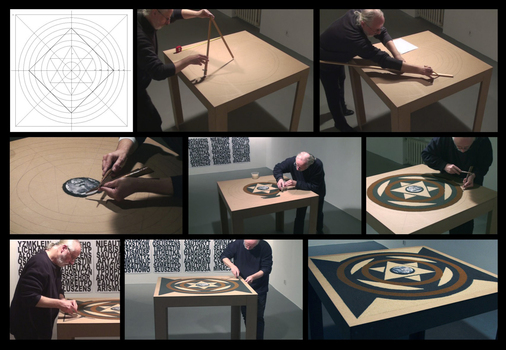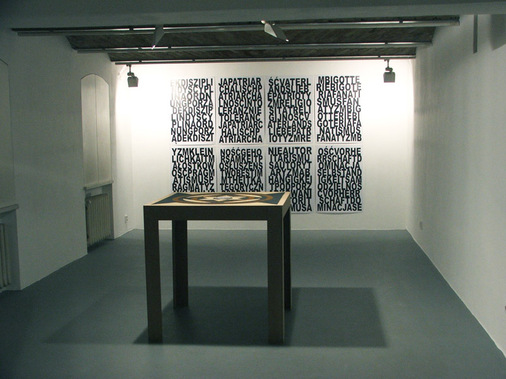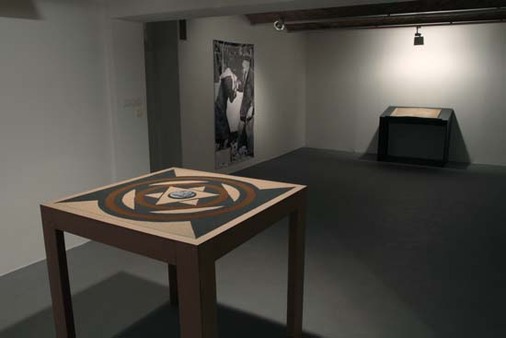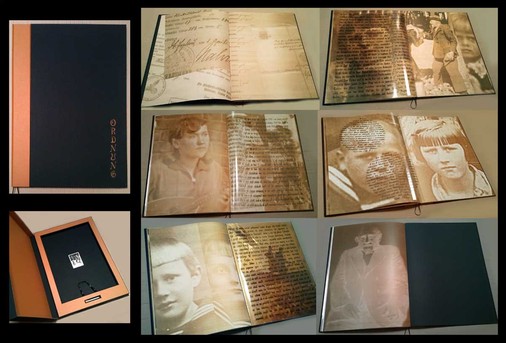KSIĄŻKA I CO DALEJ 13 / BOOK AND WHAT NEXT 13
TOMASZ WILMAŃSKI
Ordnung
08 - 19.12.2014
Główna idea wystawy „ORDNUNG”, prezentowanej w Galerii AT nawiązuje do czasu, historii i pamięci, jak i do szeroko rozumianej egzystencji. Obejmuje refleksją to, co możemy intelektualnie, a zarazem bezpiecznie, przejąć dla siebie z historii dzięki pamięci. Niemieckie słowo „ordnung” (porządek), użyte jako tytuł tej wystawy, odnosi się, ogólnie mówiąc, do precyzji myślenia, porządkowania świata, harmonii natury. Może kojarzyć się pozytywnie, a zarazem sugerować różne obsesje, np. pedantyzm, rygor, ślepe posłuszeństwo etc. Wilmański nawiązuje tu także, w pewnym sensie, do określenia Ordnung muss sein, które jest znane w Polsce jako idiom i ma wiele różnych odniesień interpretacyjnych. W pracy tej artysta opiera się przede wszystkim na dokumentach i faktach z historii własnej rodziny, uwikłanej w historyczno-polityczne zawirowania mające korzenie w XIX w., gdy Polski nie było na mapie Europy. W jakimś sensie kluczową, ale tylko symboliczną postacią jest tu jego dziadek Walter, urodzony na terenie Pruskiego Pomorza. Aczkolwiek pretekstem do tej wypowiedzi artystycznej mogłaby być każda rodzina o podobnej historii, żyjąca w podobnym czasie lub współcześnie. Artysta daleki jest od tworzenia epopei rodu z którego się wywodzi. Nie to jest celem jego wystawy. Unikatowa książka artystyczna (tekst w niej zawarty) stanowi podstawowy element dla całej prezentacji. Z pozoru realizacja ta, opierająca się w dużej mierze na wspomnieniach, zasłyszanych historiach, często tylko domniemaniach, trudno rozpoznawanych postaciach ze starych fotografii etc., jest podróżą w przeszłość. Jeśli jednak zagłębimy się w sensy tej realizacji, dojdziemy do wniosku, że autor mówi przede wszystkim o uniwersalnej idei wolności oraz zagrożeniach, które mogą wynikać np. ze „złego” rodzinnego wychowania (edukacji), stresowego traktowania dzieci, co może być w przyszłości przyczyną nacjonalistycznej ideologii, nietolerancji lub religijnego fanatyzmu. Problemach ciągle aktualnych, dziejących się obok nas tj. np. muzułmański fundamentalizm, rasizm, agresywna homofobia, nacjonalizm rosyjski lub antysemityzm. W pracy „ORDNUNG” czytelne są zarówno fascynacje Tomasza Wilmańskiego mające swoje korzenie w filozofii buddyjskiej (np. usypywanie rytualnych mandali przez mnichów tybetańskich), jak i bliska mu jest idea sztuki związanej z poezją konkretną, książką artystyczną, fotografią.
The work of Tomasz Wilmanski is based chiefly on documents and facts about his family, entangled in historical and political turbulence rooted in the 19th century, when Poland had been erased from the map of Europe. In a sense, a crucial, albeit a symbolic figure here is our grandfather, Walter, who was born in Prussian Pomerania. The project of this exhibition was created at the beginning of the book. The layer of iconography, I mean the photographs and texts in the book, Tomasz Wilmanski applied deliberately blurred images, hazy, ambiguous character of the photographs are deliberately fuzzy, barely discernible. As if suspended in time and available memory. He said me: there's nothing more important that they are our relatives. It could be every family had a similar history, living in a similar time or today. He is farthest to attempt a saga of his family. That is not the purpose of his exhibition. Unique art book is crucial to the understanding of the presentation, and reading it is suggested as the first step to experience the exhibition. The drawing in the sand symbolizes transience, volatility of events and people. Tiny grains of sand have a cosmological value, represent the ephemeral universe, while rust symbolizes the process of decay. Also, the act (and time) of creation and destruction drawing with sand plays a major role in the creative of this work. It is in a sense, the process of meditation, purifying and crystallizing thinking spiritual identity. Seemingly this realization, based to a considerable degree on reminiscences, overheard stories, sometimes on mere assumptions and almost unrecognizable silhouettes from old photographs etc. is a journey into the past. However if we delve into the meanings of this artistic statement, we will come to a conclusion, that the author speaks first and foremost about the universal ideas of freedom and the dangers that can arise for example from the "bad" family upbringing (education), stress treatment of children, which may cause nationalist ideology, intolerance or religious fanaticism. Problems still current, happening next to us. For example: Muslim fundamentalism, racism, Russian nationalism or Anti-Semitism. In presentation "Ordnung" we can trace both Tomasz Wilmanski's fascination with Buddhist philosophy (eg,. creating ritual mandala by Tibetan monks), as well as visual and concrete poetry, art book and photography.





